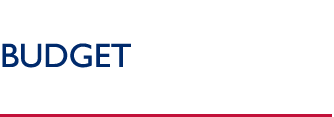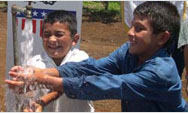 |
|
 |
 |
|
 |
 |
 |
USAID Information:
External Links:
|
|
 |
 |
|
 |
 |
|
Guyana


Please note: All linked documents are in PDF format
| Objective |
SO Number |
FY 2004 |
FY 2005 |
FY 2006 |
| Reduced Impact of HIV/AIDS |
504-005 |
1,700 |
|
|
| Democratic Governance Consolidated |
504-006 |
1,848 |
1,937 |
2,438 |
| Environment for Sustained Growth of Exports |
504-007 |
1,000 |
1,485 |
1,500 |
| Total (in thousands of dollars) |
4,548 |
3,422 |
3,938 |
|
The Development Challenge: Guyana currently faces a multitude of development challenges: a weak economy, rising crime, poor security, continued out-migration, the specter of HIV/AIDS, and a political climate that threatens its ability to consolidate democracy. Guyana's socioeconomic statistics reflect this reality: gross national product per capita in 2003 was $860, down slightly from $900 in 2002; maternal mortality is 190 per 100,000 live births and infant mortality is 54 per 1,000, both relatively high for the Latin America and Caribbean region; and the HIV/AIDS epidemic in Guyana is second to Haiti in the region.
Although no official figures exist for out-migration, the country has been losing its educated professionals. This loss of human capital undermines the Government of Guyana's (GOG) capacity to provide quality health, education, and social services; impedes government administration and management; and fosters dependence on donors. The private sector also suffers from these human resource constraints because the limited availability of qualified personnel requires the difficult choice between either increasing personnel costs and straining finances, or lowering standards.
On political matters, public confidence in the two main political parties has deteriorated. The main opposition party, People's National Congress/Reform, has broken off a constructive engagement process initiated in May 2003 with the ruling People's Progressive Party/Civic, and is again boycotting most sessions of parliament. There are also rising concerns over Guyana's role as a trans-shipment country for the illicit drug trade.
Despite these many challenges, an important window of opportunity now exists as a result of the GOG's stated commitment to meaningful political and economic reform. Guyana has qualified to apply for FY 2005 Millennium Challenge Account (MCA) threshold program assistance. USAID, in partnership with MCA, will take the lead in assisting the Government to submit a proposal for policy, economic, and governance reforms necessary to improve country performance in the MCA eligibility indicators.
Guyana's untapped economic potential augurs well for reversing any negative trends, allowing it to emerge as a force for economic prosperity in the region. The country possesses enormous underutilized forestry, mineral, and fishery resources. Poised on the northern coast of South America, it is uniquely well positioned to serve as a gateway for trade between North America and Brazil. An all-weather road between the Brazilian border and Georgetown, Guyana is being discussed among the two countries, international financial institutions, and private investors. This road would create a variety of new commercial opportunities for local investors, U.S. businesses, and other foreign investors. With continued U.S. support for private sector organizations and political and economic reform, foreign direct investment can be expected to rise significantly.
This is a pivotal and promising time in Guyana. USAID is confident that its strategic plan will support the government and the people of Guyana in their efforts to overcome the many developmental challenges facing the country.
The USAID Program: By building on previous successes and incorporating lessons learned, USAID's country assistance strategy for Guyana aims to optimize the impact of the human, technical, and financial resources the U.S. Government is committing to Guyana.
The current strategy period, which extends until 2008, includes three objectives that aim to: 1) reduce the transmission of HIV and the impact of AIDS; 2) consolidate democratic institutions; and 3) create economic prosperity by improving the environment for value-added exports.
Guyana is a focus country under the President's Emergency Plan for AIDS Relief. FY 2005 funding will be provided from the Global HIV/AIDS Initiative under the policy direction of the U.S. Global AIDS coordinator. The FY 2006 HIV/AIDS request for this country is contained in the Global HIV/AIDS Initiative account justification. For further details please see the Department of State FY 2006 Congressional Budget Justification."
Other Program Elements: In addition to the programs managed by the USAID mission in Guyana, several regional programs managed by the Economic Growth, Agriculture, and Trade (EGAT) Bureau are implemented in Guyana. The Farmer to Farmer program employs voluntary technical assistance to improve horticultural production, processing, and marketing, with a focus on fruit and vegetable husbandry and aquaculture. The Southern Guyana Biodiversity Corridor Planning and Implementation Project, part of the Global Conservation Program, is working to maintain and recover priority biodiversity areas in the Kanuku Mountains/Rewa River triangle of southern Guyana. Activities include identification of critical areas, biological assessments, socioeconomic surveys, legal analysis, and community mapping.
Guyana is a focus country under the President's Emergency Plan for AIDS Relief. FY 2005 funding will be provided from the Global HIV/AIDS Initiative under the policy direction of the U.S. Global AIDS coordinator. The FY 2006 HIV/AIDS request for this country is contained in the Global HIV/AIDS Initiative account justification. For further details please see the Department of State FY 2006 Congressional Budget Justification.
Other Donors: Donor coordination continues to be very strong. As one of the major donors in Guyana, USAID participates regularly in donor meetings and provides leadership and policy input on democratic, economic, and social reforms. The largest bilateral donors are the United States, the United Kingdom (education, infrastructure, and social development), and Canada (education, environment, and fisheries). The major multilateral donors and their principal areas of focus include: World Bank, (public sector reform, HIV/AIDS, water and sanitation, and education); Inter-American Development Bank (water and sanitation, air transport, and social and urban development); European Union (sea defense, water and sanitation, transportation, and communications.
Back to Top ^
|


